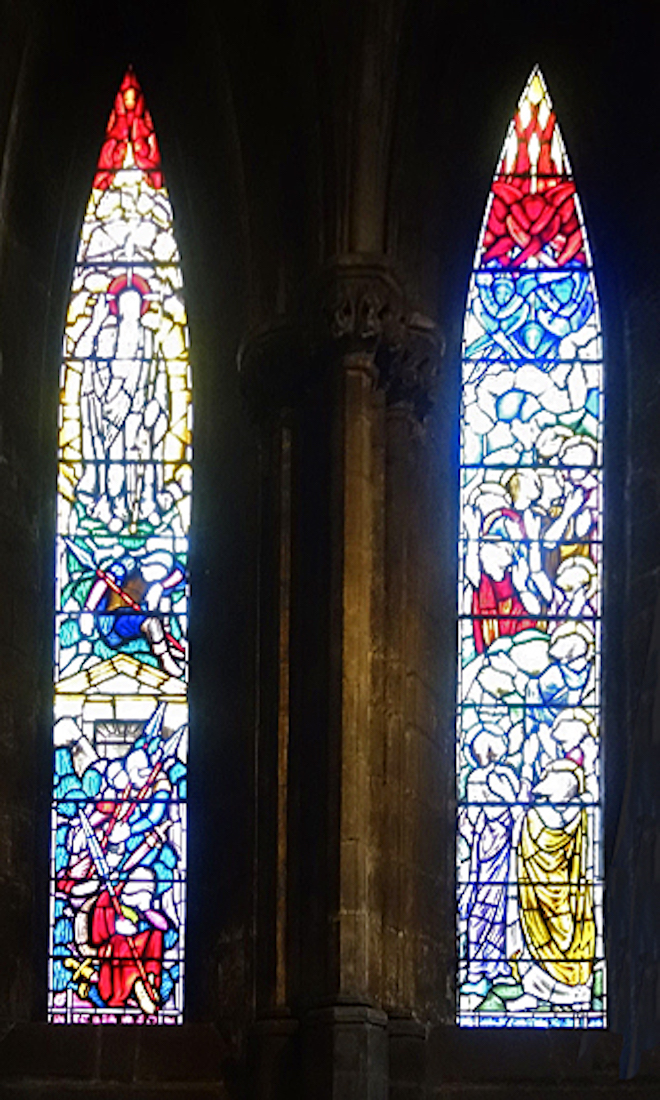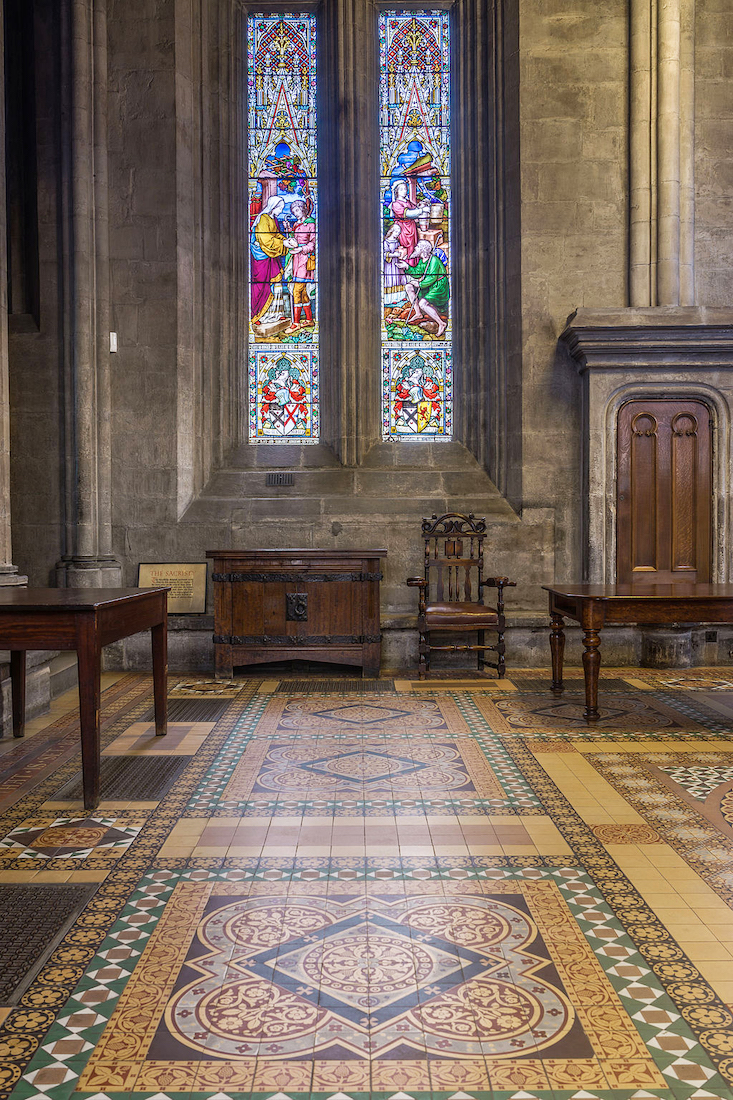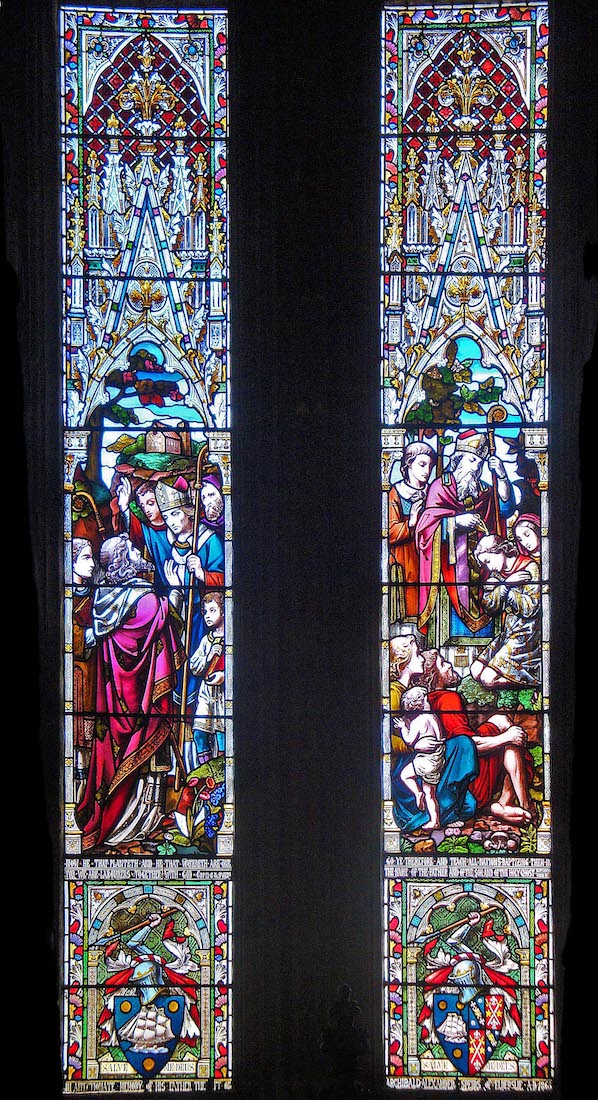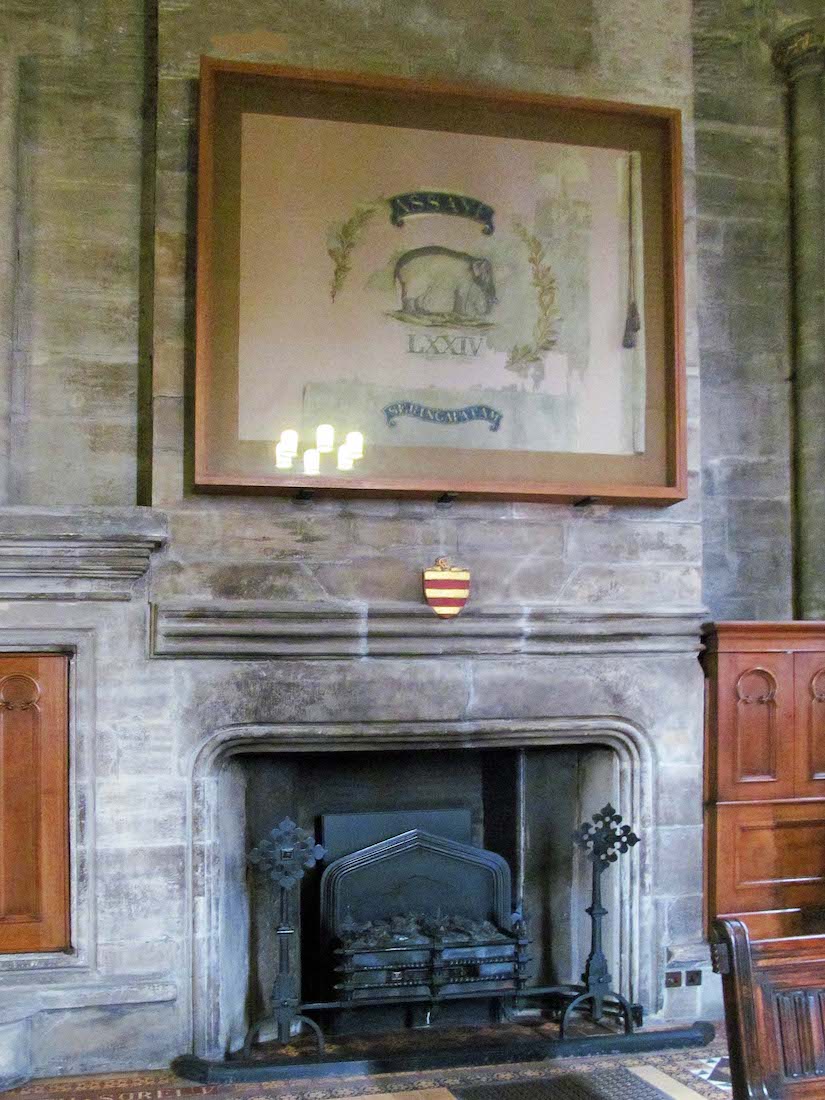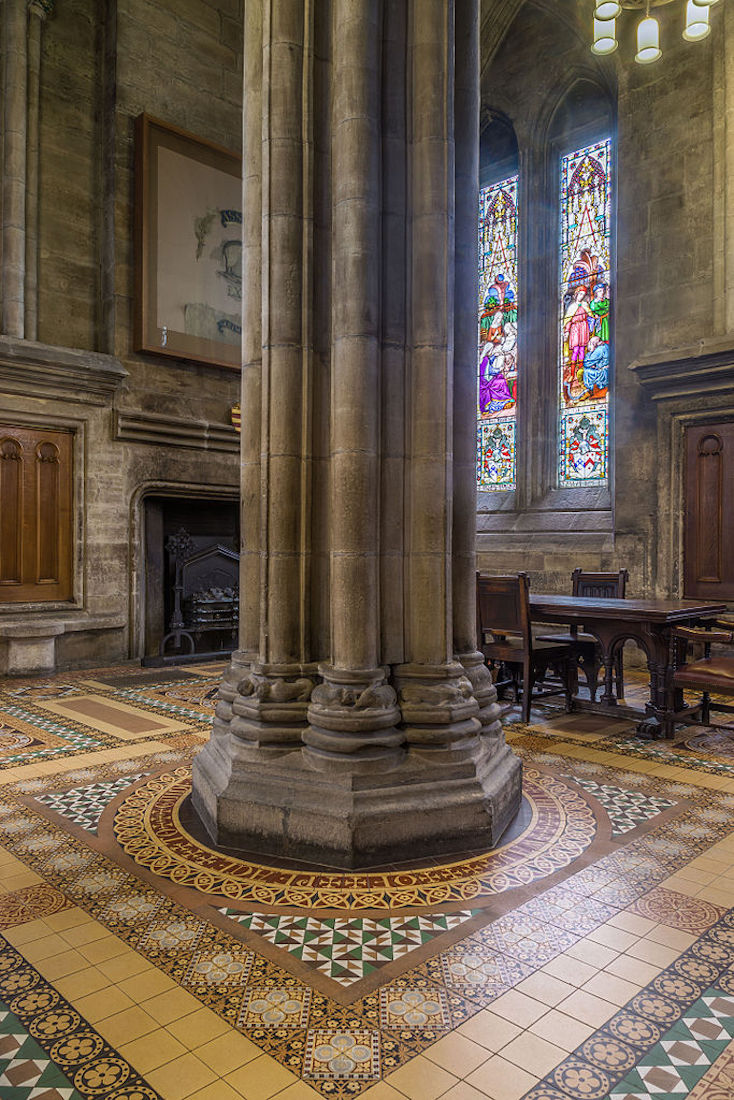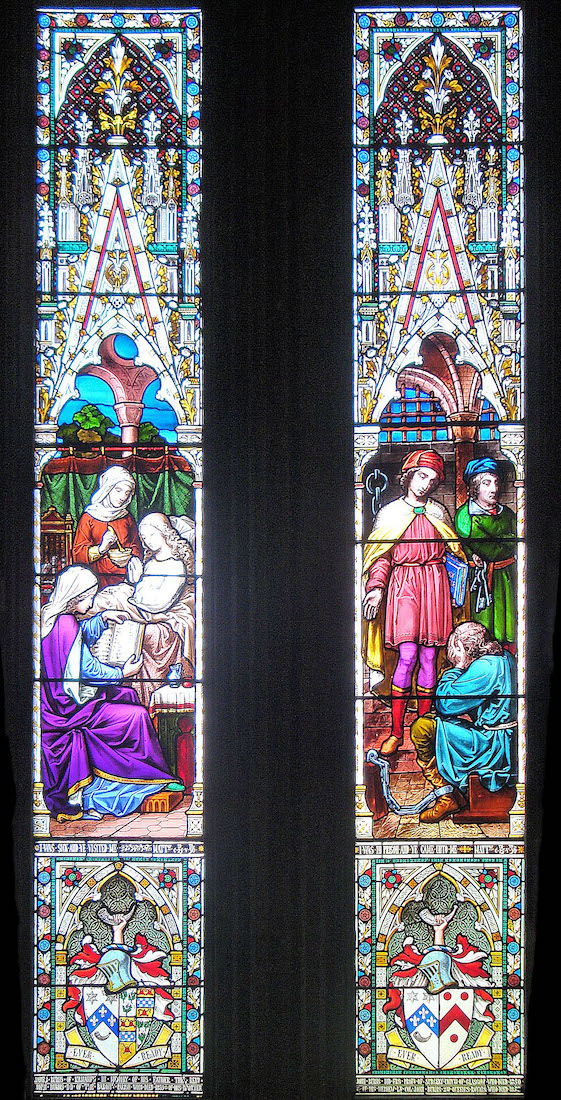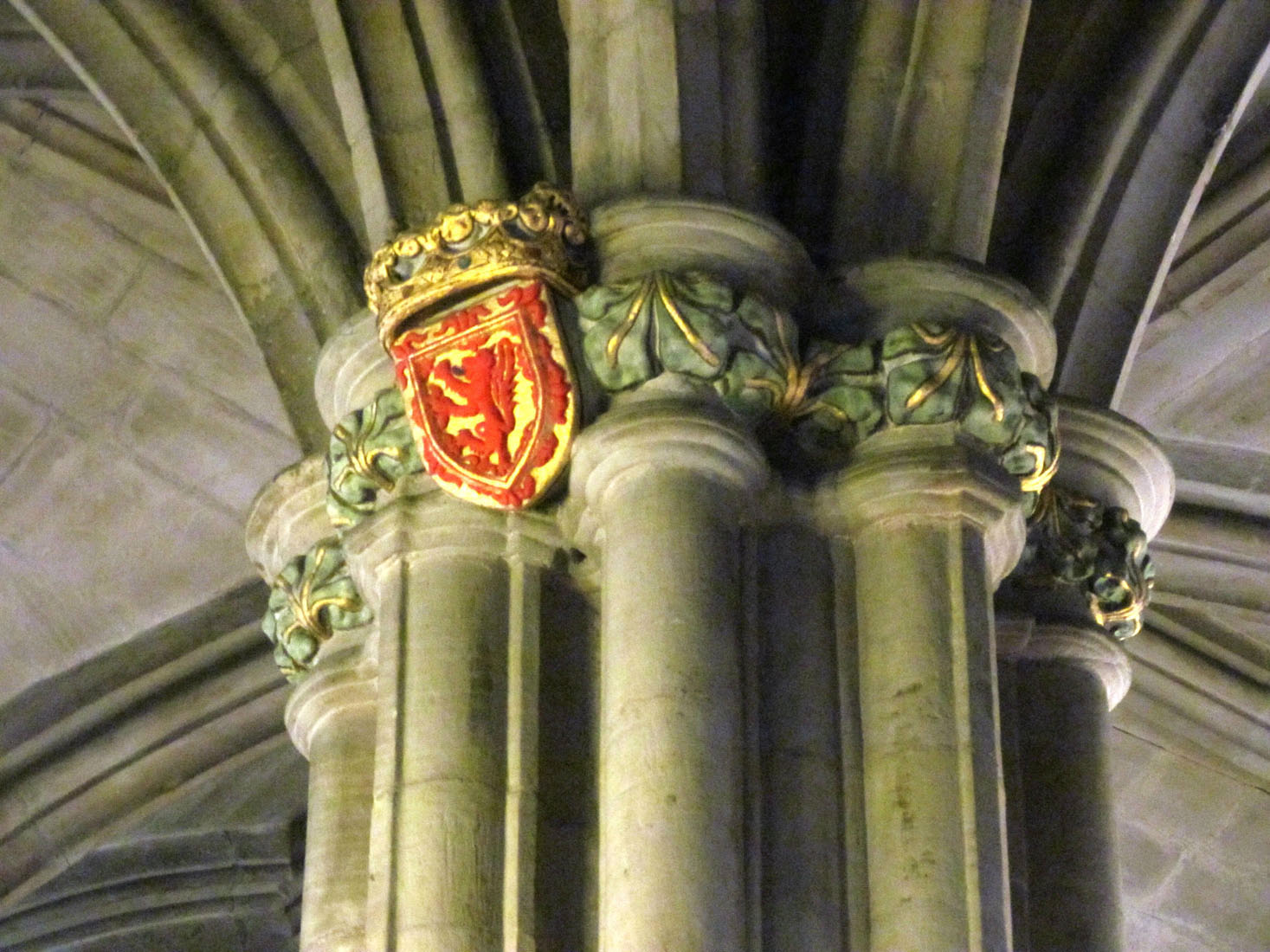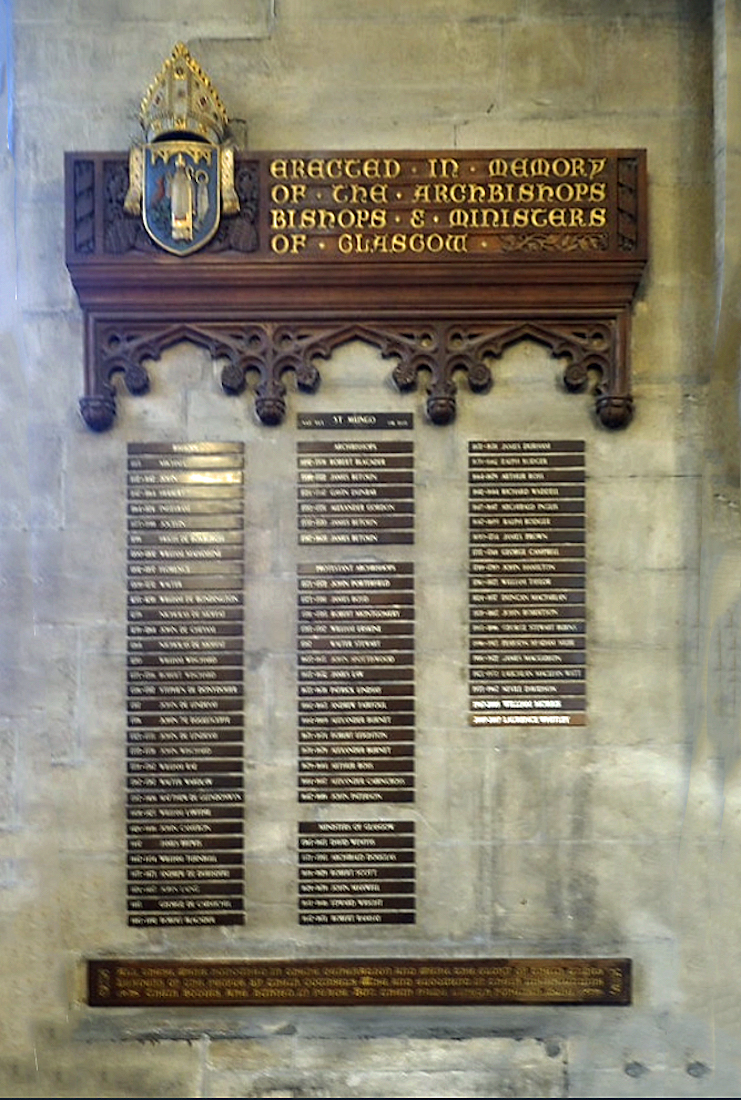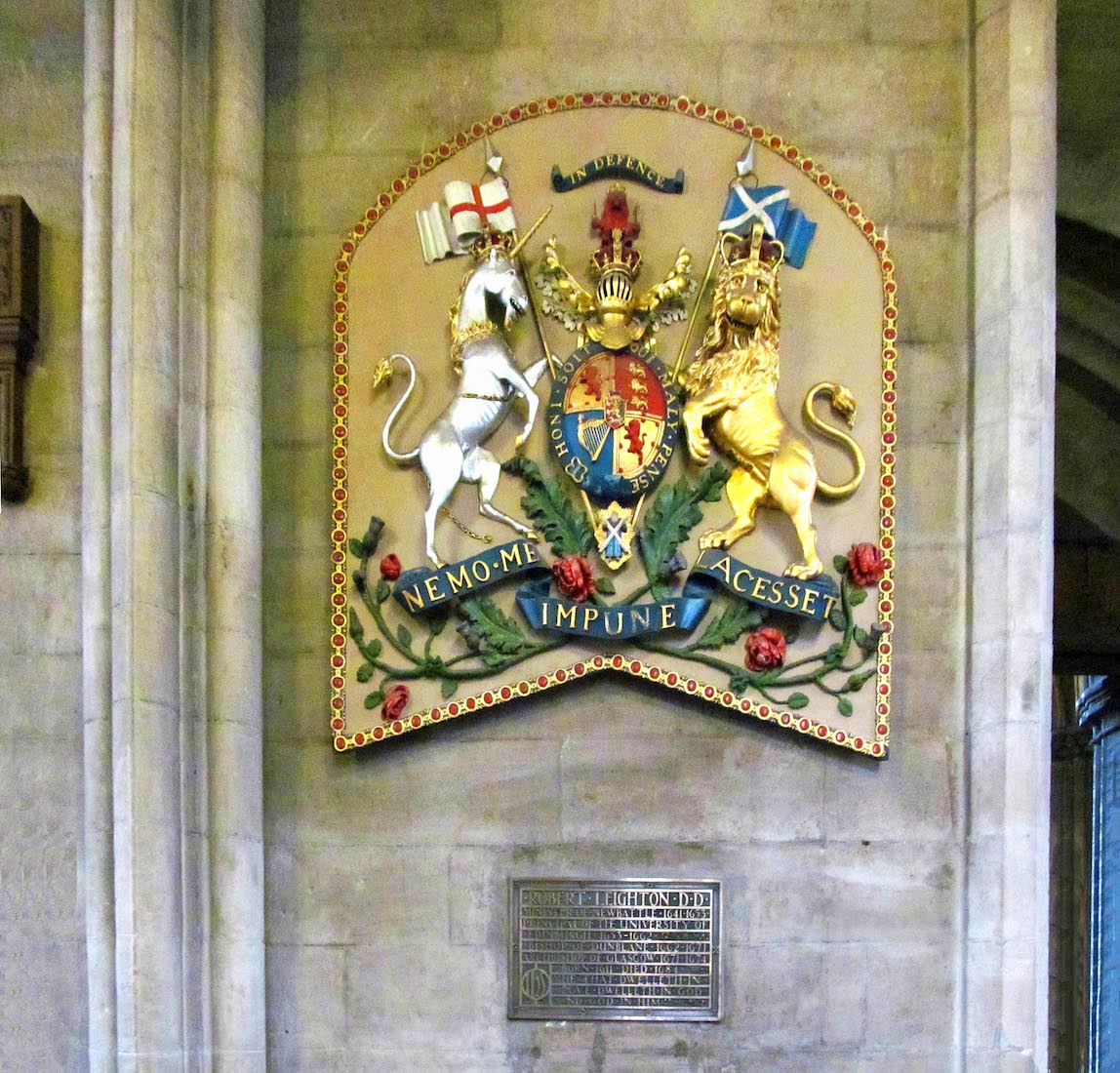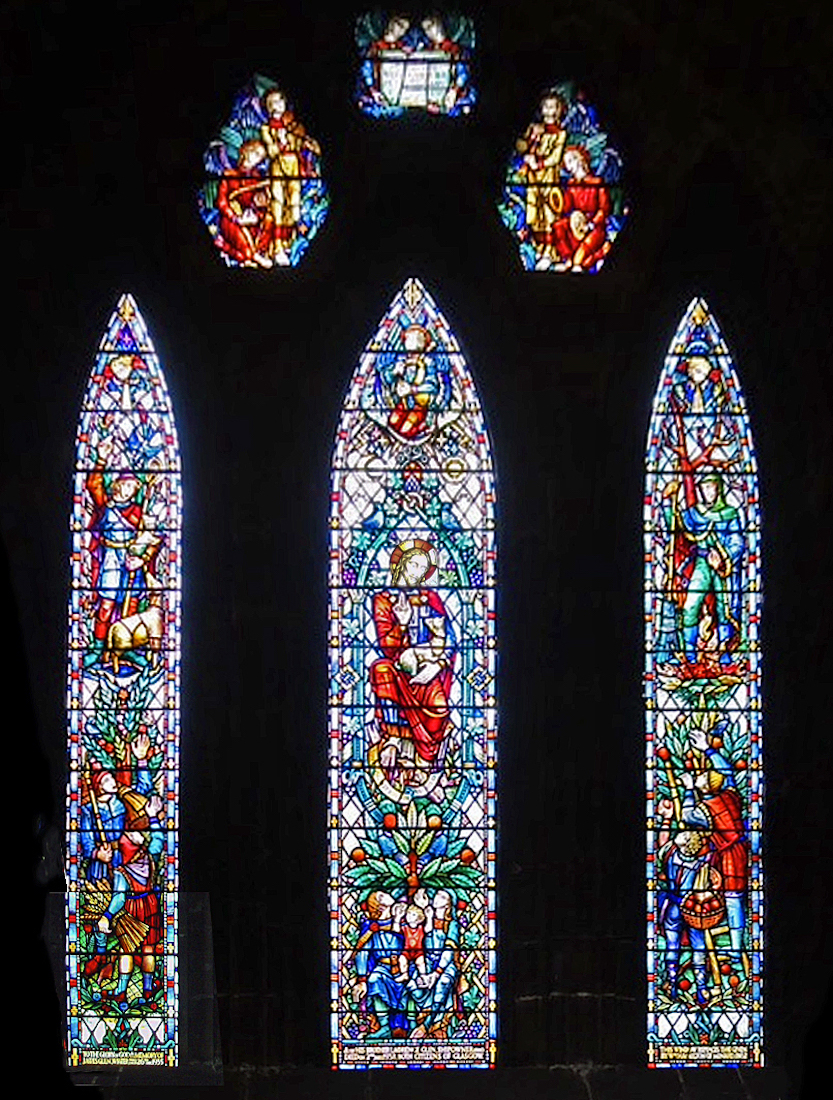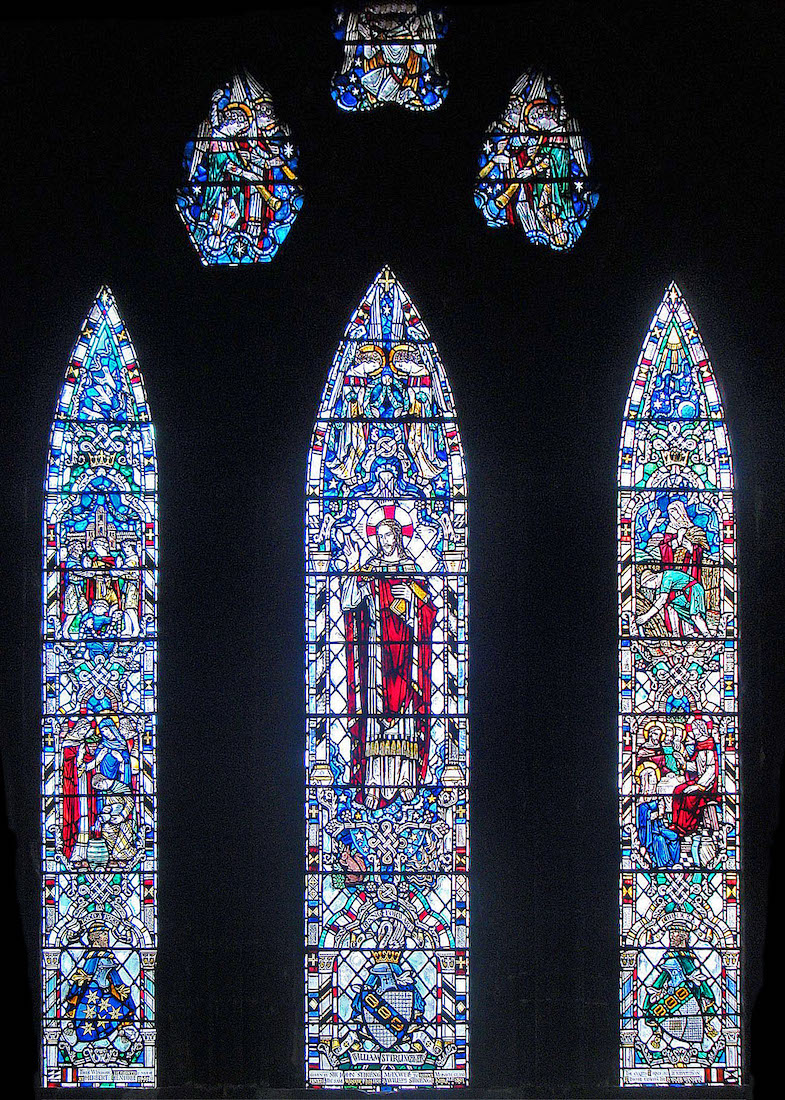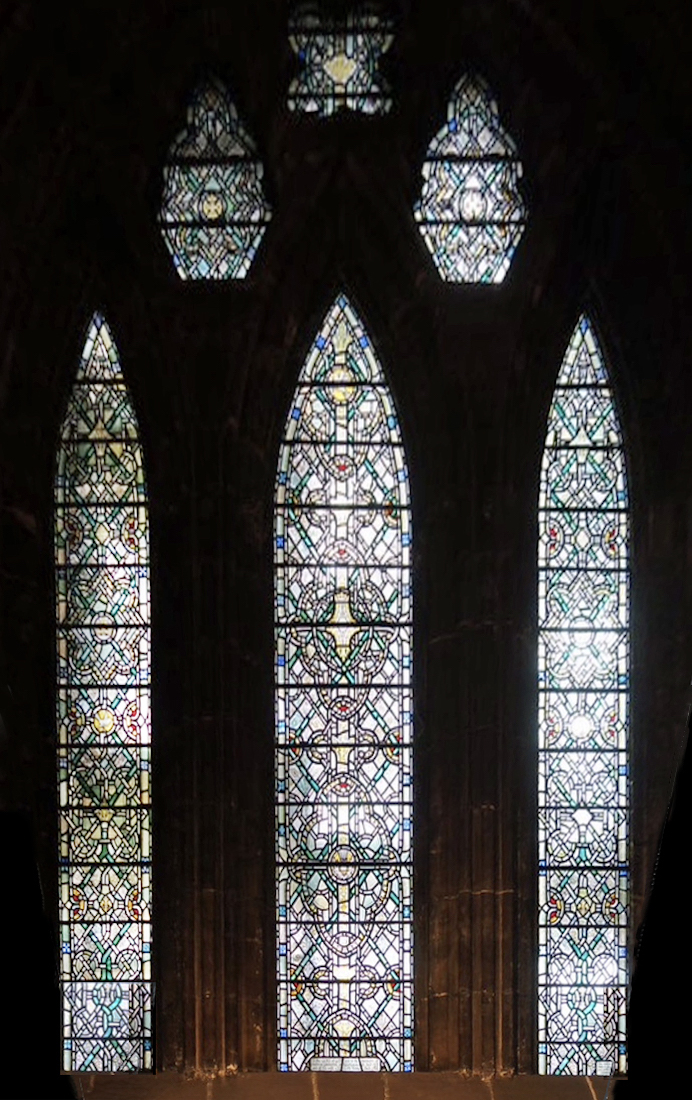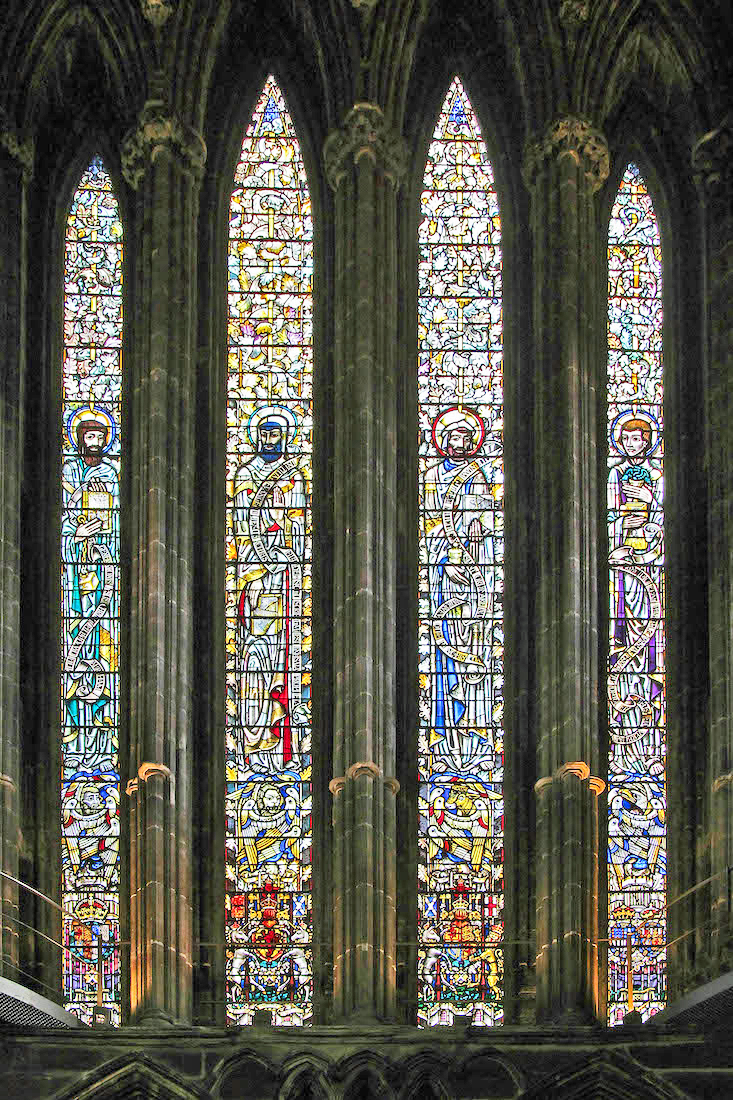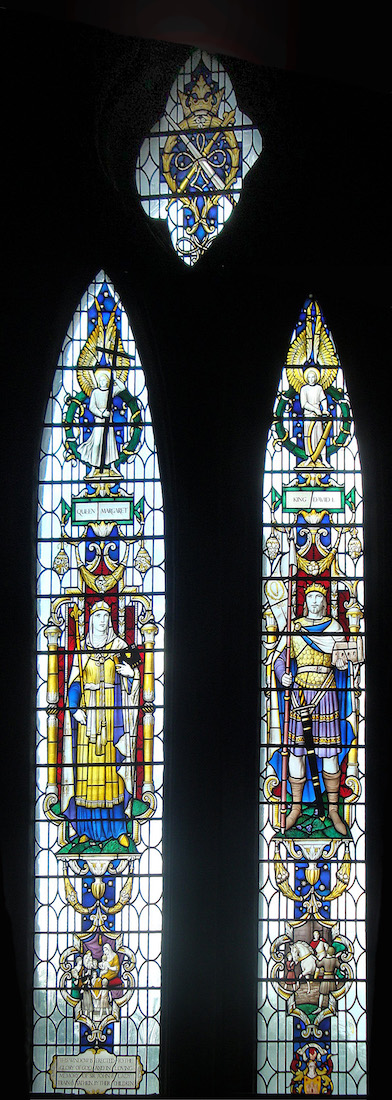

The left (East) window on the South wall of the chapel depicts Queen Margaret and King David I. It is by Christopher Webb (1954). The window at right is a two-light grisaille window incorporating Masonic emblems Each of the lights incorporates a panel echoing the shape of the top tracery. . INDEX
Q14. CHAPEL DETAILS IS IS IS
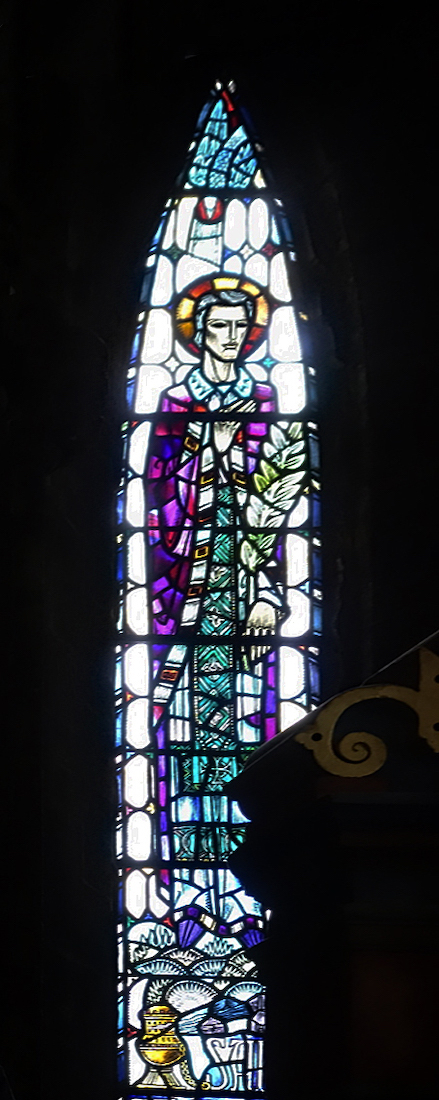
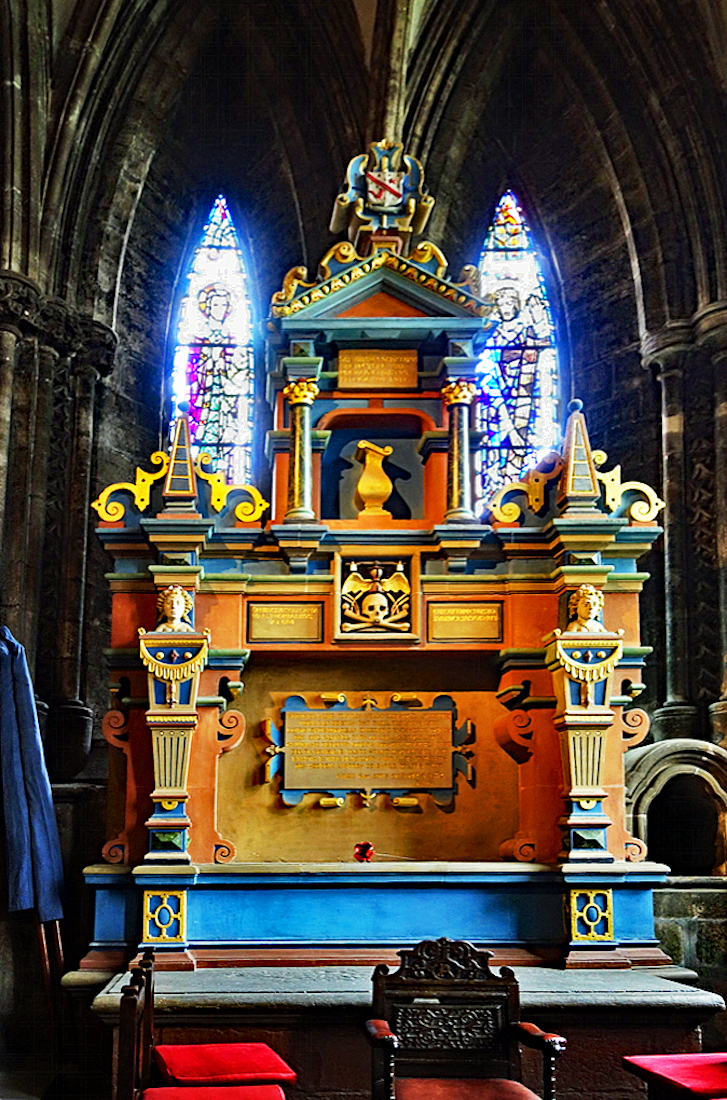

We notice that the archbishop’s monument has a skull and crossbones! The windows by Gordon Webster (1975) depict St Stephen and St Lawrence. They are a memorial to Lord Bisland, who played an important role in the restoration of the Cathedral.
Q15. EAST CHAPEL WH IS
The next chapel, the Chapel of St James the Greater, is usually called the East Chapel. The communion table has an 18th century Italian frontal. Before the table is an eastern rug with a Tree of Life design. The two prayer desks each have a Cathedral crest on the front. The brass eagle lectern with onyx and agate stones was given to the Revd Dr George Burns by the congregation in 1890 to mark his silver jubilee. The two windows represent the Resurrection and the Ascension of Jesus. They form the second pair of a set of four windows by Francis Spear; we shall see the first pair in the next chapel.
Q16. CHAPEL OF ST MARTIN WH IS
We next come to the Chapel of St Martin. Here there is an oak showcase given by Mr Turnbull, an elder. It contains pewter communion plates and flagons; metal Communion tokens dated 1725, 1776 and 1819. Such a token was an essential means of admission to Holy Communion in Scottish parishes from the 17th century until early in the 20th. There is also in the case a Reader's Bible printed in 1617 and used in former days by the Reader during the devotions before the preacher entered the pulpit. The windows show the Nativity and the Crucifixion of Christ. They are the first pair in a set of four windows by Francis Spear, given by an anonymous donor.
Q17. CHAPEL OF ST NINIAN IS IS
The final chapel along this Eastern ambulatory is the Chapel of St Ninian. This is not now in use as a chapel, but there are two colourful windows. The left window shows St Columba and Iona Abbey. The right window depicts St Ninian and Candida Casa at Whithorn. Both windows are by Marion Grant (1955). We move on to the archway leading to the Upper Chapter House.
UCH2. SOUTH AISLE W-C IS
The Chapter House is an annexe built, probably in the mid thirteenth century, on the Northeast corner of the Cathedral. It was rebuilt in the fifteenth century, beginning in the time of Bishop William Lauder. The upper stage is now used as a sacristy. At left is the view along the South side, looking West. This window illustrates the text from Matthew 25:35 : For I was an hungred, and ye gave me meat: I was thirsty, and ye gave me drink. [Left Photo credit: CCL © User-Colin-Wikimedia Commons]
UCH3. NORTHWEST CORNER IS W-C IS
There is a single old chair standing in the Northwest corner, and two more windows. The window at left on the West wall is based on Scripture verses from Matthew 25. The North facing window on the right shows St Kentigern meeting St Columba, and St Kentigern baptising new converts. The windows here are by artist Henry Hughes of London, and were installed between 1862 and 1865. [Centre Photo credit: CCL © User-Colin-Wikimedia Commons]
UCH4. FIREPLACE WH IS
There is a large fireplace against the North wall, with a framed flag hanging above. The flag was awarded to the 74th Highland Regiment of Foot by the Governor General of India in 1803. It was known as the ‘Assaye Colour’. It was a white silk flag bearing an elephant with regimental number ‘LXXIV’ and the places ‘Assaye’ and ‘Seringapatam’. The colour continued to be carried by the 2nd Battalion HLI from 1881 to 1948, and the 1st Battalion from 1948 to 1959. Notice the little shield above the fireplace.
UCH5. NORTHEAST CORNER W-C IS
Beyond the large central column we see the fireplace and the Northern window on the East wall. The window illustrates Matthew 25:36: ‘I was sick, and ye visited me: I was in prison, and ye came unto me’. [Left Photo credit: CCL © User-Colin-Wikimedia Commons]
UCH6. COLUMN CAPITAL CRESTS WH WH
Looking up to the top of the column we see these coats of arms. On the capital of the central pillar are the arms of King James I of Scotland (seen here at left) and of Bishop Cameron, 1426-46, the builder, whose shield is also seen above the fireplace.
UCH7. TILE WH
One of the delights of the Upper Chapter House is the exquisite tiled flooring. There are strips of text along each wall and around the base of the central column. A strip along the East side reads: ‘Ponder the Path of Thy Feet and let all Thy Ways be Established’ (Proverbs 4:26).
UCH8. SOUTHEAST CORNER WINDOWS IS IS
The second Eastern window shown at left illustrates the verse Matthew 25:35: ‘I was a stranger and ye took me in: naked and ye clothed me’. The single lancet window on the South wall was given by Andrew MacGeorge of Glasgow.
UCH9. LIST OF BISHOPS IS
On the South wall is a list of all the Archbishops, Bishops and Ministers of the Cathedral. The earliest bishops, Magswen and John Scotus, date from around 1055; the first archbishop was Robert Blacader (Blackadder) [Bishop 1483–1492, Archbishop 1492–1508]. After the Scottish Reformation, the earliest archbishops were John Porterfield (1571–1572) and James Boyd of Trochrig (1573–1581). The earliest ministers of Glasgow were David Wemyss (1565–1615) and Archibald Douglas (1571 – 1593).
UCH10. COAT OF ARMS IS IS
Just East of the entry door is this impressive coat of arms of King James I of Scotland. The lower text translates to , ‘No one can harm me unpunished’. The words around the crest, HONI SOIT QUI MAL Y PENSE, translate to, ‘Shame on anyone who thinks evil of it’.
QUIRE (CONTINUED)
Q18. NORTH QUIRE WINDOWS I IS IS
We leave the Upper Chapter House and return to the North aisle of the Quire. The first two windows are shown. • At left is the Good Shepherd window (also called Christ and the World’s Beauty) by Sadie McLellan (1955). Sadie F McLellan (1914 - 2007), was a Scottish stained glass artist whose work can be found in many churches and buildings around Scotland. • At right are St Andrew and St James – a stained glass window by Herbert Hendrie (1946) donated by Sir Archibald Campbell of Succoth. St Andrew is shown with his martyr’s cross, while St James, patron saint of Scottish kings, is shown in pilgrim’s dress.
Q19. NORTH QUIRE WINDOWS II AMT IS
Moving towards the pulpitum, we come to the next two windows. The window at left is known as the Stirling of Keir window (also, Christ and the World’s Happiness), and is by Herbert Hendrie (1887-1946). It was given by Sir John Stirling Maxwell to replace the Munich glass placed in the same window by his father William Stirling of Keir MP, 1861. Herbert Hendrie (1887-1946) was born in Manchester and trained as a painter in London at the Slade School and the Royal College of Art. He later moved to Edinburgh and in 1908 set up the Department of Stained Glass at Edinburgh Art College. The window shows Christ holding a Bible at the centre of a colourful world. • The grisaile window at right is by Edward Liddal Armitage (1953). The aim was to create a jewel like effect. Small and brilliant fragments of red, blue and gold pick out the general patterns of the window which lets a great deal of light into this darker side of the Cathedral.
Q20. NORTH QUIRE WINDOWS II IS IS
These are the final two windows along the Northern quire aisle. • The window at left is Christ and the World’s Work, by Herbert Hendrie (1940). It was the only window to be installed in the Cathedral during WWII. The central figure shows Christ holding an axe, symbolising his work on earth as the carpenter of Nazareth. Smaller surrounding panels show fishermen and industrial workers. • At right is a stained glass grisaile window by Carl Edwards (1951). This is a medieval type of window, usually grey, but some colour has been added here.
Q21. QUIRE ALTAR GC
Having explored the quire aisle, we now turn to the central sanctuary area. High in front of us is the Great East Window. Below is the communion table and Cross, facing a wide open area covered with red carpet. Nearest us is a pulpit at left, and an eagle lectern at right. If we look very carefully, there is another eagle lectern, standing behind and just to the right of the altar. The red carpet has symbols of St Mungo, with the tree at the centre. There is also a gold carpet which is laid down at different times of the year.
Q22. SANCTUARY WH
Our eyes are drawn up to the Great East window.
Q23. GREAT EAST WINDOW WH
The great East Window was installed in 1951. It shows the four Evangelists, St. Matthew, St. Mark, St. Luke and St. John. Below each Evangelist is his traditional emblem: from left, a man (angel), a lion, an ox, and an eagle. It is by Francis Spear who uses the simple but effective technique of tilting the heads of the figures differently, relieving any monotony that might have resulted from the design. The colour in the window is used sparingly, with only the heads and the cloaks being coloured. The Royal Coat of Arms at the bottom of each light commemorates the previous Munich windows which were a gift of Queen Victoria. Click here for a zoomed in view.



